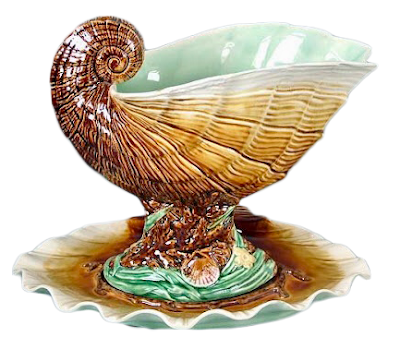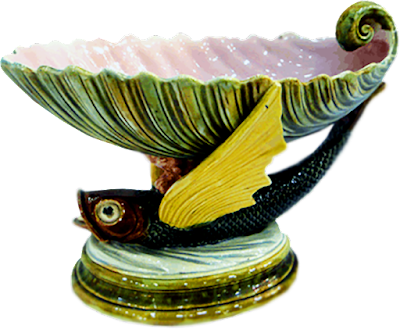When you're buying on the secondary market, it's always a good idea to maintain a certain degree of skepticism about the authenticity of the object you're buying.
In the early 1990's I was a relative fledgling antiques dealer specializing in majolica. I had been buying for a few years by this time, but not a real seasoned professional by any means. As is typical for antiques dealers I traveled around the USA quite a bit, driving from antique show to antique show, setting up my wares and buying as I came across things.
On one of my trips to the Metrolina Antiques Show in Charlotte, North Carolina I saw a large, very heavy majolica pitcher that I had never seen before. It was cobalt blue with large, three dimensional strawberries on it and a stippled background. I picked up the piece and examined it. There was something about it that wasn't quite right but I couldn't really put my finger on it. It had some wear and some dirt on it and was heavily crazed throughout. The underside showed dirt on the unglazed foot, a good sign that a piece had been around for a while. As I recall, the price was around $345. Since that seemed to be more of a retail price than wholesale price I passed on the pitcher and continued my rounds through the fair grounds.
Fantasy new majolica strawberry pitcher
After about an hour of walking around the fair I came across a second example of the same pitcher but in a bright opaque yellow glaze. Again, I picked up the pitcher and examined it. Like the first one it was very heavy for its size and showed crazing and dirt throughout. The price of this one I believe was around $385. I put the pitcher down and after a bit left the fair grounds for my next stop, Atlanta, Georgia.
I spent the week antiquing my way through Atlanta before hitting the Scott Antiques Show the following weekend. To make a long story short, in that time I saw three more of these pitchers in turquoise, brown and green.
I knew something was up. Here was a pitcher pattern that I had never seen before and it was suddenly everywhere. When I returned to Pennsylvania I started to see the same pitcher at various antiques shows, handled by some very well known majolica dealers. Soon the pitcher was showing up everywhere, from flea markets to the antique show of the Majolica International Society,
Majolica Madness.
By this time I was convinced that it had to be a reproduction, but one done by someone who was very careful to add signs of age to it with the dirt and crazing. Still, the piece was selling like hotcakes throughout the majolica circuit, usually selling for about $350-500 a piece. The word on the street was that this was new "old" stock that had been discovered shuttered in a warehouse for many, many years.
I just didn't buy it.
Soon afterwards two different pitchers and an oyster plate surfaced that had identical characteristics to the strawberry pitcher. One pitcher was a very large pitcher with a stork on it that had been pictured in one of the Marks
Majolica books and the other, a huge pitcher with a stippled body and bunch of fruit at the neck. The oyster plate is an identical copy of the Palissy fish head plate normally found in green or pale steel blue but in a bright blue color palette
Reproduction majolica crane pitcher
Fantasy new majolica fruit pitcher
Reproduction palissy oyster plate
The original fish head palissy oyster plate
The pitcher with the fruit was easy to dismiss because it was another pattern no one else had ever seen--though that didn't stop it from selling very well at antique shows and fairs.
The other two were more troubling. These were copies of real majolica patterns--very, very good copies.
When word got around that these copies were in circulation it completely destroyed the market for the genuine articles. Soon, knowledgeable dealers refused to carry the pitcher and oyster plate because they couldn't tell the difference between the real thing and the reproduction. For many years the patterns became pariahs with many dealers refusing to handle them.
Eventually all four of the pieces started to disappear and within a generation had succeeded in being absorbed into collections with many of the purchasers none the wiser. Today these pieces show up in dealers booths and auctions and generally command very good prices from those who don't know the history of the patterns
This is where the story
should end, but it doesn't!
On one of my trips down South a few years ago, I came upon a dealer's booth filled with the fish oyster plates. The dealer handled real majolica but these plates were being sold as new for $35 a piece. When I asked the dealer about them I was told that they were buying them directly from the manufacturer, a tiny pottery in South Carolina, run by a gentleman with whom they had an exclusive contract.
Soon the pieces of the puzzle started to come together for me.
These reproductions that were being potted in the South were being purchased as new and working their way up the East coast as antiques. They were being sold as antiques by people who were either unintentionally or intentionally misled. Considering the care with which these pieces were "aged" I suspect it was the latter. I never did find out who that potter in South Carolina was but it gives me a cold chill to know that these reproductions, to this day, have fooled hundreds if not thousands of people into adding them to their collections. This is why I always tell new collectors to buy from dependable sources who know what they're selling.
An interesting post script to all this.
Recently other potteries that make reproductions of majolica have started copying the reproductions, probably without knowing they were reproductions in the first place.
Both the large strawberry pitcher and the blue, palissy oyster plate have hundreds of copies of them floating around out there.
In an odd way you could say, what goes around comes around.
































































































